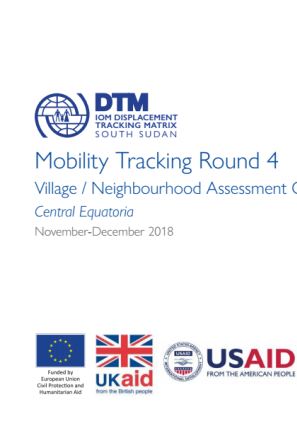-
Countries
-
Data and Analysis
-
Special Focus
-
Crisis Responses
South Sudan
South Sudan
IDPs tracked
Displacement Movements
1,121,000
IDMC 2023
Data collection round
About South Sudan
Conflict and instability in South Sudan have resulted in large-scale internal and cross-border displacement since the December 2013 crisis of over 4 million individuals. In September 2018, the Revitalized Agreement for the Resolution of the Conflict in South Sudan (R-ARCSS) was signed between the major warring parties. Whilst overall there have been improvements in security since and returns are ongoing, fighting and communal clashes (frequently linked to cattle raiding) continue to trigger new displacements and the situation remains volatile.
DTM South Sudan’s toolbox is designed to meet critical information gaps during all phases of response, from preparedness, to intervention and transition/recovery. DTM South Sudan provides country-wide figures on the numbers, locations and priority needs of IDPs and returnees updated on a quarterly and ad-hoc basis. The programme undertakes biometric registration in selected parts of the country to support partners with reaching intended beneficiaries during distributions. Flow monitoring data is collected on a daily basis at displacement sites, key transit hubs and border crossing points to identify mobility dynamics of migrants including IPDs and returnees. Through ad hoc surveys, headcounts, infrastructure/service mapping exercises and other assessments, DTM provides additional information to support partners in planning their response.
Contact
IOM South Sudan DTM Juba
ISSDTM@iom.int
Current Donors
- Switzerland
- Japan
- DFID
- ECHO
- OCHA
- OFDA
- Canada (DFATD)
- WFP
- UN Peacebuilding Fund
- World Bank
South Sudan — Unity I Catalogue — Mobility Tracking Round 4
This catalogue contains multi-sectoral profiles for all assessed villages and neighbourhoods (host-community locations) in Central Equatoria, based on DTM’s Mobility Tracking Round 4 data. Please use the interactive table of contents to navigate the report.
South Sudan — Upper Nile Catalogue — Mobility Tracking Round 4
This catalogue contains multi-sectoral profiles for all assessed villages and neighbourhoods (host-community locations) in Upper Nile, based on DTM’s Mobility Tracking Round 4 data. Please use the interactive table of contents to navigate the report.
South Sudan — Warrap Catalogue — Mobility Tracking Round 4
This catalogue contains multi-sectoral profiles for all assessed villages and neighbourhoods (host-community locations) in Warrap, based on DTM’s Mobility Tracking Round 4 data. Please use the interactive table of contents to navigate the report.
South Sudan — Western Bahr el Ghazal Catalogue — Mobility Tracking Round 4
This catalogue contains multi-sectoral profiles for all assessed villages and neighbourhoods (host-community locations) in Western Bahr el Ghazal, based on DTM’s Mobility Tracking Round 4 data. Please use the interactive table of contents to navigate the report.
South Sudan — Sites Catalogue — Mobility Tracking Round 4
This catalogue contains multi-sectoral profiles for all assessed IDP camps and camp-like sites in South Sudan, based on DTM’s Mobility Tracking Round 4 data. Please use the interactive table of contents to navigate the report.
South Sudan — Western Equatoria II Catalogue — Mobility Tracking Round 4
This catalogue contains multi-sectoral profiles for all assessed villages and neighbourhoods (host-community locations) in Western Equatoria, based on DTM’s Mobility Tracking Round 4 data. Please use the interactive table of contents to navigate the report.
South Sudan — Western Equatoria I Catalogue — Mobility Tracking Round 4
This catalogue contains multi-sectoral profiles for all assessed villages and neighbourhoods (host-community locations) in Western Equatoria, based on DTM’s Mobility Tracking Round 4 data. Please use the interactive table of contents to navigate the report.
South Sudan — Central Equatoria Catalogue — Mobility Tracking Round 4
This catalogue contains multi-sectoral profiles for all assessed villages and neighbourhoods (host-community locations) in Central Equatoria, based on DTM’s Mobility Tracking Round 4 data. Please use the interactive table of contents to navigate the report.
South Sudan — Bentiu PoC site Headcount (March 2019)
As per the March 2019 headcount, the population stands at 100,441 individualsThe Bentiu Protection of Civilian (PoC) site was established in December 2013. As of March 2019, 159,175 beneficiaries remained registered in the site.
South Sudan — Wau PoC AA Headcount (March 2019)
Population by Zone and block, Wau PoC AA (March 2019): 14,226 individuals
Apr 09 2019
South Sudan — Wau PoC AA Headcount (March 2019)
South Sudan — Event Tracking: Yei County (9 April 2019)
Clashes between government (SSPDF) and opposition forces have led to ongoing displacement in areas of Yei County.
Apr 09 2019
South Sudan — Event Tracking: Wau PoC AA site…
South Sudan — Event Tracking: Aweil North & East (9 April 2019)
Majokyinthiou, Jaac and Kiir Adem are some of the main points of entry between Sudan and South Sudan in Northern Bahr El Ghazal.
Apr 09 2019
South Sudan — Event Tracking: Aweil North & Ea…
South Sudan — Event Tracking: Dulu, Raja (9 April 2019)
Dulu, Raja within Raga County of Western Bahr el Ghazal has recently experienced a large influx of South Sudanese nationals coming from Darfur, Sudan who entered the area transiting through Boro Medina.
South Sudan — Shelter Count: Korijo IDP Site (Feb 2019)
Following conflict-driven displacement from existing IDP camps in Central Equatoria, (including IDP sites Logo Kerewa, and Ajio), IDPs gathered in Korijo Camp in late 2018. Following reports of emergency humanitarian needs, IOM CCCM participated in an OCHA-initiated IRNA.
South Sudan — Wau PoC AA Headcount (February 2019)
Current population of Wau PoC AA: 13,630 individuals
South Sudan — Bentiu PoC Headcount (February 2019)
The Bentiu Protection of Civilian (PoC) site was established in December 2013. As of February 2019, 159,647 beneficiaries remained registered in the site.
South Sudan — Mobility Tracking Report 4 (31 March 2019)
During Round 4 of Mobility Tracking (Nov-Dec 2018), 1,275,868 IDPs and 866,846 returnees were identified.87% of counties and 59% of subareas were assessed.
South Sudan — Displacement Site Flow Monitoring (Feb 2019)
IOM’s Displacement Tracking Matrix (DTM) interviewed 4,319 households representing 7,494 travelling individuals crossing into and out of Bentiu Protection of Civilians site (PoC) site, Malakal PoC site, Wau PoC Adjacent Area (AA) site and Wau collective centres (Cathedral, Nazareth, St.
South Sudan — Flow Monitoring Dashboard (February 2019)
DTM’s Flow Monitoring Registry (FMR) surveys people on the move at key transit points within South Sudan and at its borders.
South Sudan — Displacement Site Flow Monitoring (Jan 2019)
IOM’s Displacement Tracking Matrix (DTM) interviewed 5,604 households (9,470 individuals) crossing into and out of Bentiu Protection of Civilians site (PoC) site, Malakal PoC site, Wau PoC Adjacent Area (AA) site and Wau collective centres (Cathedral, Nazareth, St.
South Sudan — Ebola Preparedness Flow Monitoring Dashboard (Feb 2019)
As part of IOM’s Ebola Virus Disease (EVD) preparedness activities, DTM operates seven Flow Monitoring Points (FMPs) in Yambio, Yei and Morobo counties and six in cooperation with DTM Uganda on the Ugandan side of the border.
South Sudan — Event Tracking: Jur River (15 March 2019)
IOM’s Displacement Tracking Matrix assessed three locations in Kuarjena, Jur River of Western Bahr el Ghazal following recent clashes between pastoralists and farmers. The unrest resulted in the displacement of 9,672 individuals who fled Akau, Werbet and Madhon (all within Kuarjena area).
South Sudan — Flow Monitoring Dashboard (January 2019)
DTM’s Flow Monitoring Registry (FMR) surveys people on the move at key transit points within South Sudan and at its borders.
Pagination
Pagination
- First page
- Previous page
- 1
- 2
- 3
- 4
- 5
- 6
Pagination
- First page
- Previous page
- …
- 13
- 14
- 15
- 16
- 17
- 18
- 19
- 20
- 21


























